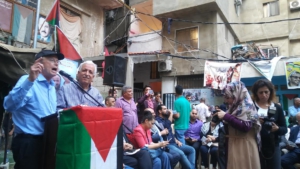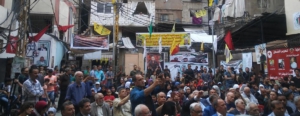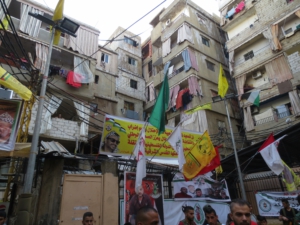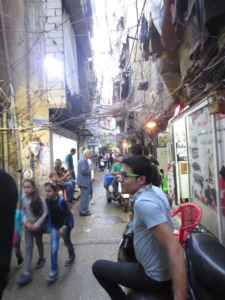
On May 15, a delegation from the Third Annual International Conference for Justice for Palestine joined a solidarity rally with the Palestinian hunger strike in the Shatila refugee camp in Beirut, Lebanon. Delegates from 35 countries attended the conference. I was invited to attend representing the Party for Socialism and Liberation.
At the rally, held on the 28th day of the mass hunger strike of more than 1300 Palestinian political prisoners, organizers from a wide range of Resistance organizations spoke of the state of the Palestinian liberation movement and called for the people to rise up in further support. They proclaimed their support for the hunger strikers in Israeli prisons fighting for better conditions who have become a galvanizing force for the Palestinian people. Among those speaking at the rally was Richard Becker, of the ANSWER Coalition, who condemned the role of the United States for providing crucial arms, funds and protection for the state of Israel.

Shatila along with neighboring Sabra refugee camp became a worldwide symbol of Palestinian oppression in 1982, when, with the crucial assistance of the Israeli military then occupying much of Lebanon, more than 2,000 Palestinians were massacred by Lebanese fascists in a three-day rampage of rape, torture and murder. The United States had guaranteed the security of the camps after the withdrawal of Palestine Liberation Organization’s military forces, but did nothing to stop the slaughter.
An American journalist and eyewitness to the aftermath, Janet Lee Stevens, wrote: “I saw dead women in their houses with their skirts up to their waists and their legs spread apart; dozens of young men shot after being lined up against an alley wall; children with their throats slit, a pregnant woman with her stomach chopped open, her eyes still wide open, her blackened face silently screaming in horror; countless babies and toddlerswho had been stabbed or ripped apart and who had been thrown into garbage piles.”
59 Palestinian refugee camps
Millions of Palestinian refugees currently live outside their homeland, and millions more inside. They have never been allowed to return or reunite with missed loved ones who live under Israel’s racist apartheid military occupation. Hundreds of thousands of these refugees suffer from extremely low and continuously deteriorating living standards as witnessed by this writer.
Since the Palestinians first mass expulsion in 1948 known as the Nakba (“catastrophe”) they have tried to find a place to rebuild their lives until they can return. Fleeing an illegal colonial project, many were placed in what were originally supposed to be temporary camps but have since become more permanent housing projects.
According to Palestinian rights group Al Awda: “Of the 4.3 million [Palestinian] refugees registered with the United Nations Relief and Works Agency (UNRWA), 33% live in UNRWA’s 59 refugee camps throughout the West Bank and Gaza Strip, Jordan, Syria and Lebanon.” The actual population size is much higher than what is registered with UNRWA. Al Awda wrote: “Palestinians are the largest and longest suffering group of refugees in the world. There are about 7.2 million Palestinian refugees worldwide.”

Shatila camp, originally built in 1949 for 3,000 people in a working class suburb of Beirut Lebanon, is now estimated to be the home for some 22,000 refugees and the population continues to grow.Thousands of Syrian refugees are now also living in the camp since the U.S. sponsored civil war broke out in Syria in 2011. Shatila has less than half a square mile of land making it an extremely densely populated area putting further strains on the already miniscule resources. Refugee residents are restricted from acquiring any other land in Lebanon and because the camp is not allowed to expand outward their sons and daughters must stay in the camp and build extra units above their family.
Dangerous shelters built far below code for lack of construction materials are the norm. Cinder block and rebar square housing units are precariously placed atop one another reaching ever taller heights, increasing the chances of collapse. Five and six stories are common and we saw many at seven stories; if any unit failed it could mean catastrophe.
Life inside Shatila

Electricity runs through a massive tangled web of wires hanging above the heads of pedestrians barely more than nine feet from the unpaved road below. The roads are more like alleys, some so narrow that you can touch both walls with either arm. The wires are spliced again and again supplying the camp with as much electricity as possible. It’s not uncommon for people or children to be electrocuted from exposed wires. Water and sewage drip down or form puddles around wires. There is no way under the current order system to organize electrical distribution in any other way.
A survivor of electric shock would be hard pressed to find medical care which hardly exists at all. There are no adequate hospitals in Shatila to deal with the health issues resulting from the environmental problems. There are open sewage drains, little fresh air, it’s always damp and usually dark except at noon. There are vermin and the salty water from the pipes is not drinkable and irritates people’s eyes and skin.
The economics for most are bleak; unemployment for Palestinians in Lebanon is more than 50 percent and in Shatila the figure is still higher. Escaping poverty is near impossible following the Lebanese government’s Ministerial Decree No. 1/289 which prohibited Palestinians from holding more than 70 different occupations. Travel for Palestinians is also restricted, preventing access to certain jobs or trading goods.
Along with UNRWA, various NGOs are responsible for providing for the camp. However their projects are underfunded and strained. UNRWA allocates resources based on population, for which there are no reliable figures in the refugee camps. In fact Lebanon has not had a country wide population census since 1932 in order to preserve its undemocratic system imposed by the French colonialists. Further the United States, the greatest friend and guarantor of Israel, dominates the United Nations and fights the Palestinians in it at all levels including providing any resources as meager as they may be.
Liberation is the goal, resistance is the path
Despite being restricted and confined, Palestinians in the camps and the people of Shatila and the other Palestinian camps are not passive victims. On the contrary, the refugee camps inside and outside Occupied Palestine continue to be the strongest centers of resistance, The Palestinian movement for liberation enjoys international support at higher and higher levels. The Boycott Divestment and Sanctions movement is active in dozens of countries bringing direct pressure on to Israel. BDS is especially popular in South Africa where the indigenous Black population which is now looking for ways to support the Palestinians had successfully fought a racist apartheid system similar to Israel. In fact former South African freedom fighters who have visited Palestine call the situation for Palestinians “far worse than anything they had faced.”
The prisoners’ hunger strike which continues today has massive support in the refugee camps and throughout the Palestinian diaspora. The prisoners are seen as a galvanizing section of the Palestinian movement and are extremely popular. At the rally in Shatila speakers repeatedly called for support for Marwan Barghouti and Ahmad Saadat two of the leaders of the strike to the giant applause and cheers of the crowd.






